这里分类和汇总了欣宸的全部原创(含配套源码):https://github.com/zq2599/blog_demos
@Service
@ConditionalOnProperty(
value="logging.enabled",
havingValue = "true",
matchIfMissing = true)
class LoggingService {
// ...
}
复制| 名称 | 链接 | 备注 |
|---|---|---|
| 项目主页 | https://github.com/zq2599/blog_demos | 该项目在GitHub上的主页 |
| git仓库地址(https) | https://github.com/zq2599/blog_demos.git | 该项目源码的仓库地址,https协议 |
| git仓库地址(ssh) | git@github.com:zq2599/blog_demos.git | 该项目源码的仓库地址,ssh协议 |



public interface TryLookupIfProperty {
String hello();
}
复制public class TryLookupIfPropertyAlpha implements TryLookupIfProperty {
@Override
public String hello() {
return "from " + this.getClass().getSimpleName();
}
}
复制public class TryLookupIfPropertyBeta implements TryLookupIfProperty {
@Override
public String hello() {
return "from " + this.getClass().getSimpleName();
}
}
复制package com.bolingcavalry.config;
import com.bolingcavalry.service.TryLookupIfProperty;
import com.bolingcavalry.service.impl.TryLookupIfPropertyAlpha;
import com.bolingcavalry.service.impl.TryLookupIfPropertyBeta;
import io.quarkus.arc.lookup.LookupIfProperty;
import javax.enterprise.context.ApplicationScoped;
public class SelectBeanConfiguration {
@LookupIfProperty(name = "service.alpha.enabled", stringValue = "true")
@ApplicationScoped
public TryLookupIfProperty tryLookupIfPropertyAlpha() {
return new TryLookupIfPropertyAlpha();
}
@LookupIfProperty(name = "service.beta.enabled", stringValue = "true")
@ApplicationScoped
public TryLookupIfProperty tryLookupIfPropertyBeta() {
return new TryLookupIfPropertyBeta();
}
}
复制package com.bolingcavalry;
import com.bolingcavalry.service.TryLookupIfProperty;
import com.bolingcavalry.service.impl.TryLookupIfPropertyAlpha;
import io.quarkus.test.junit.QuarkusTest;
import org.junit.jupiter.api.Assertions;
import org.junit.jupiter.api.BeforeAll;
import org.junit.jupiter.api.Test;
import javax.enterprise.inject.Instance;
import javax.inject.Inject;
@QuarkusTest
public class BeanInstanceSwitchTest {
@BeforeAll
public static void setUp() {
System.setProperty("service.alpha.enabled", "true");
}
// 注意,前面的LookupIfProperty不能决定注入bean是否实力话,只能决定Instance.get是否能取到,
//所以此处要注入的是Instance,而不是TryLookupIfProperty本身
@Inject
Instance<TryLookupIfProperty> service;
@Test
public void testTryLookupIfProperty() {
Assertions.assertEquals("from " + tryLookupIfPropertyAlpha.class.getSimpleName(),
service.get().hello());
}
}
复制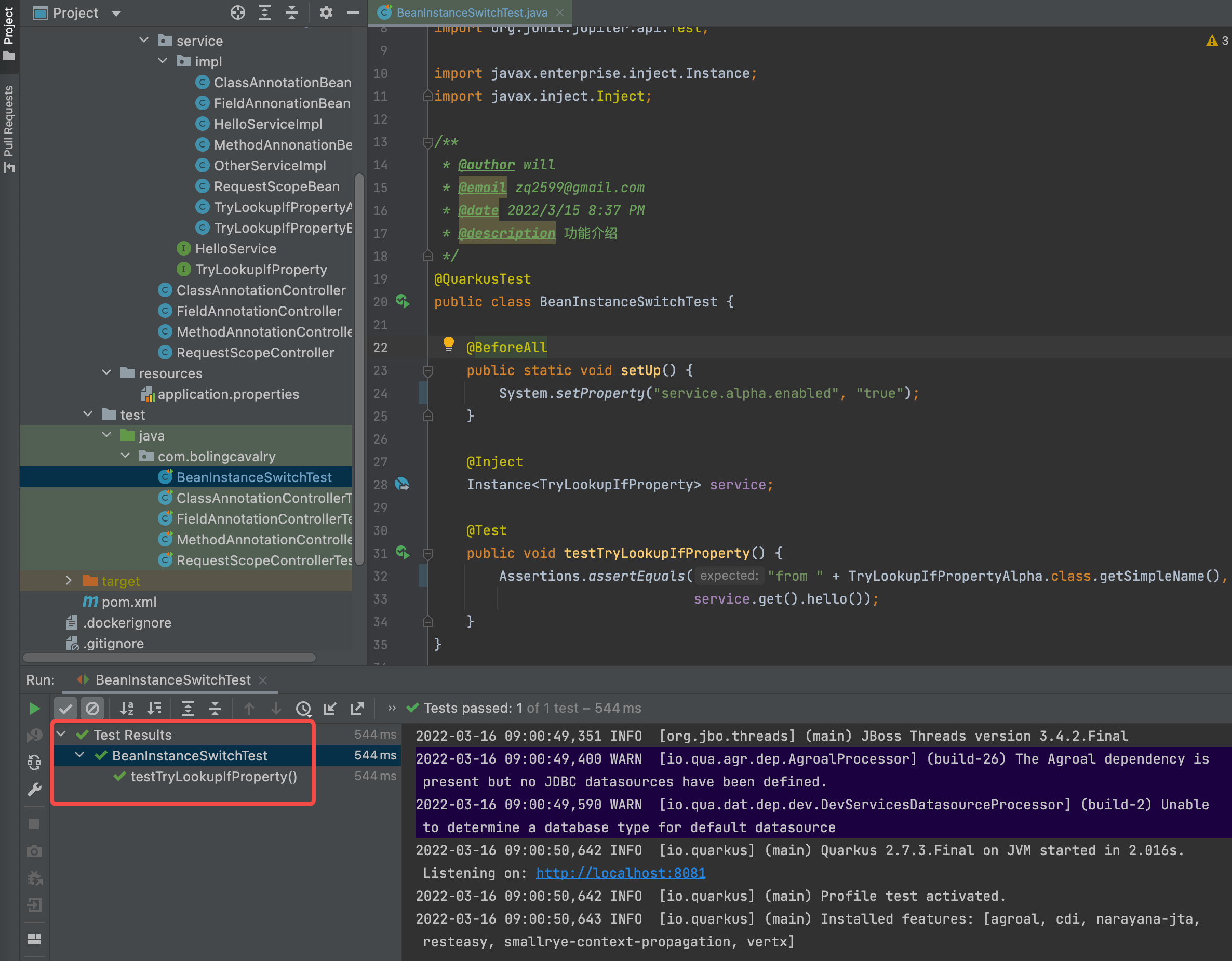
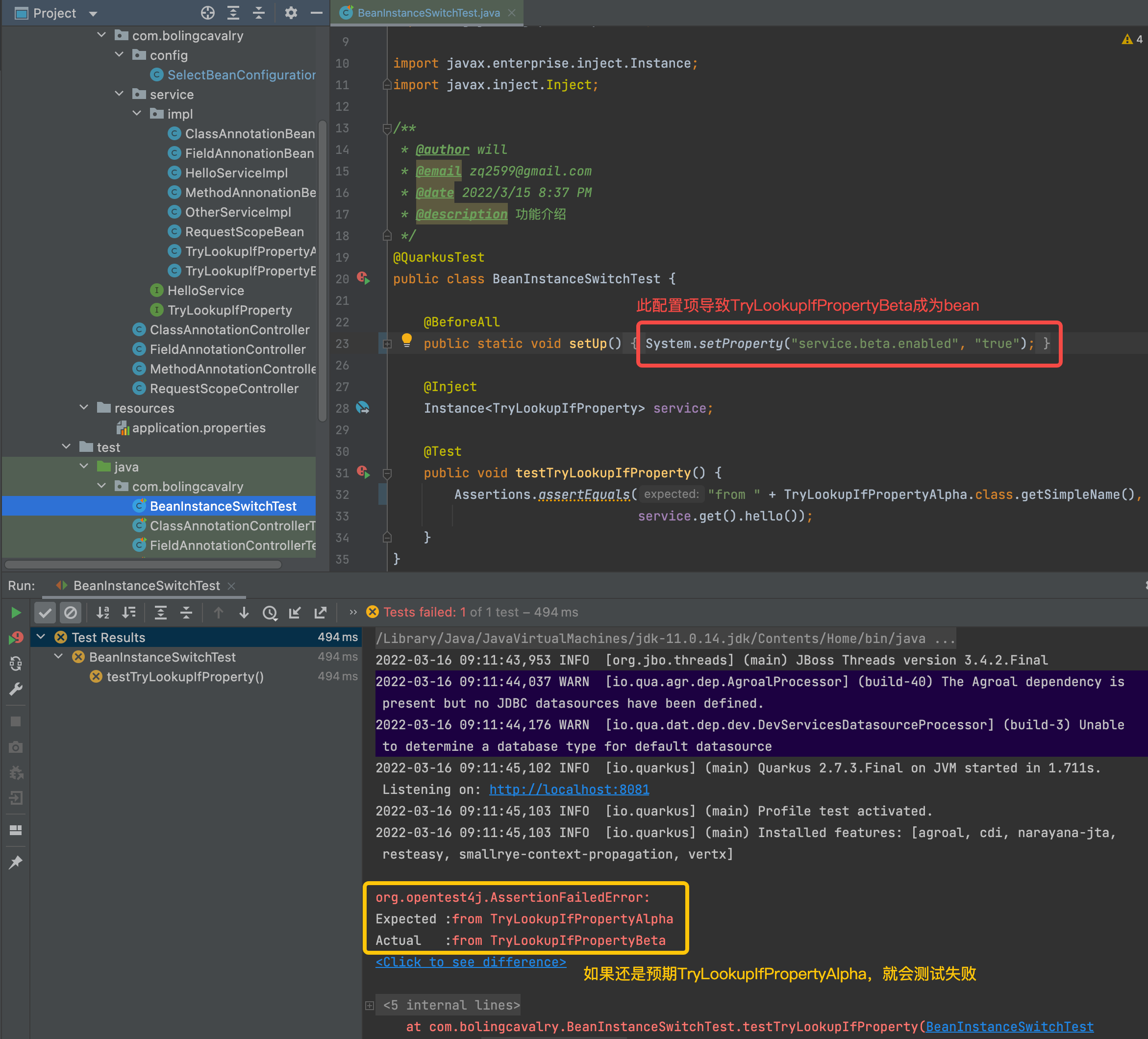
LookupIfProperty的意思是配置项的值符合要求才会创建bean,而LookupUnlessProperty恰好相反,意思是配置项的值不符合要求才能使用bean
为了验证LookupUnlessProperty的效果,修改SelectBeanConfiguration.java,只修改tryLookupIfPropertyBeta方法的注解,由从之前的LookupIfProperty改为LookupUnlessProperty,属性也改为service.alpha.enabled,现在的逻辑是:如果属性service.alpha.enabled的值是true,就执行tryLookupIfPropertyAlpha,如果属性service.alpha.enabled的值不是true,就执行tryLookupIfPropertyBeta
public class SelectBeanConfiguration {
@LookupIfProperty(name = "service.alpha.enabled", stringValue = "true")
@ApplicationScoped
public TryLookupIfProperty tryLookupIfPropertyAlpha() {
return new TryLookupIfPropertyAlpha();
}
@LookupUnlessProperty(name = "service.alpha.enabled", stringValue = "true")
@ApplicationScoped
public TryLookupIfProperty tryLookupIfPropertyBeta() {
return new TryLookupIfPropertyBeta();
}
}
复制@BeforeAll
public static void setUp() {
System.setProperty("service.alpha.enabled", "true");
}
复制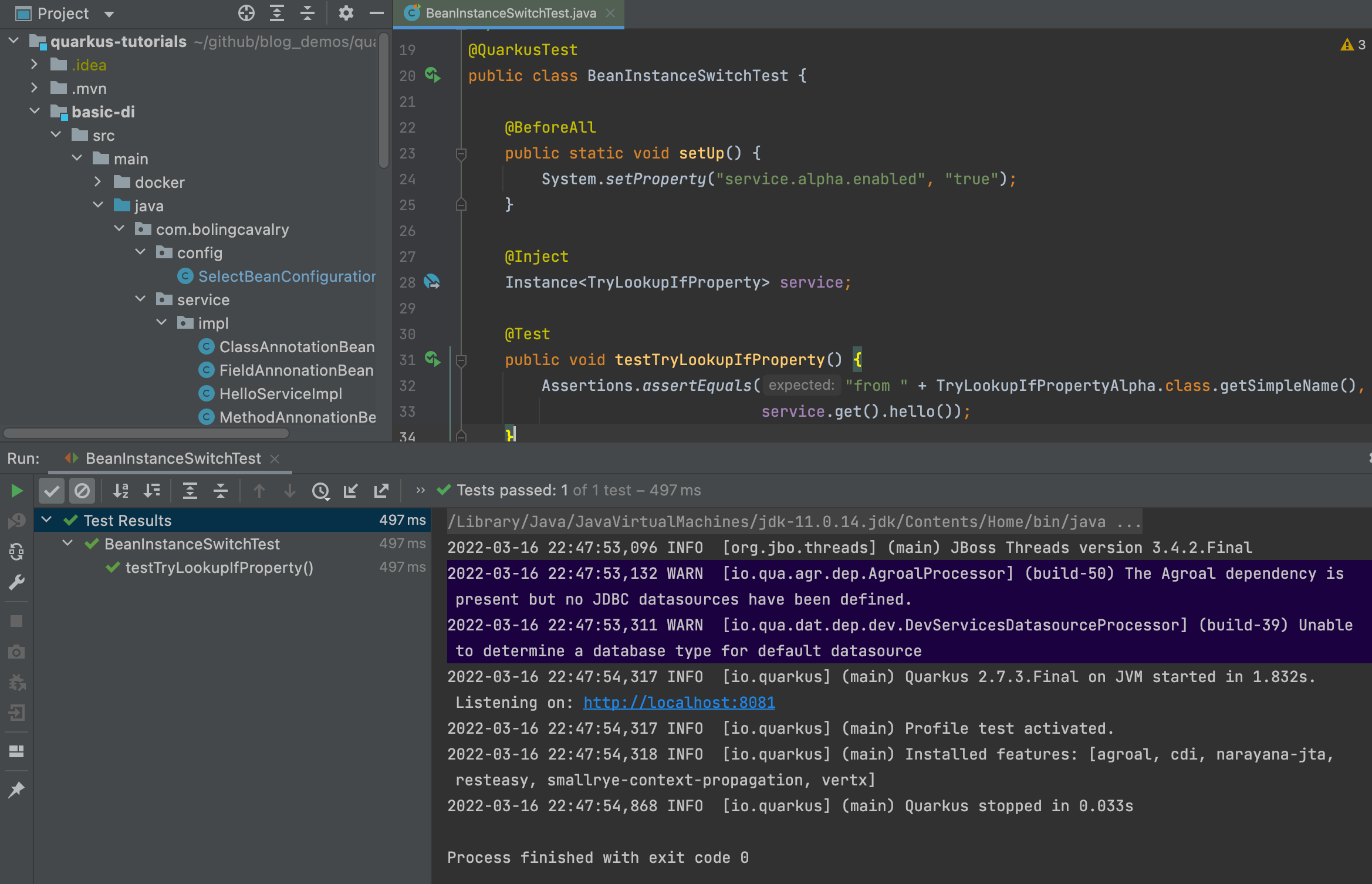
现在把service.alpha.enabled的值设为false,单元测试不通过,提示返回值是TryLookupIfPropertyBeta,这也是符合预期的,证明LookupUnlessProperty已经生效了
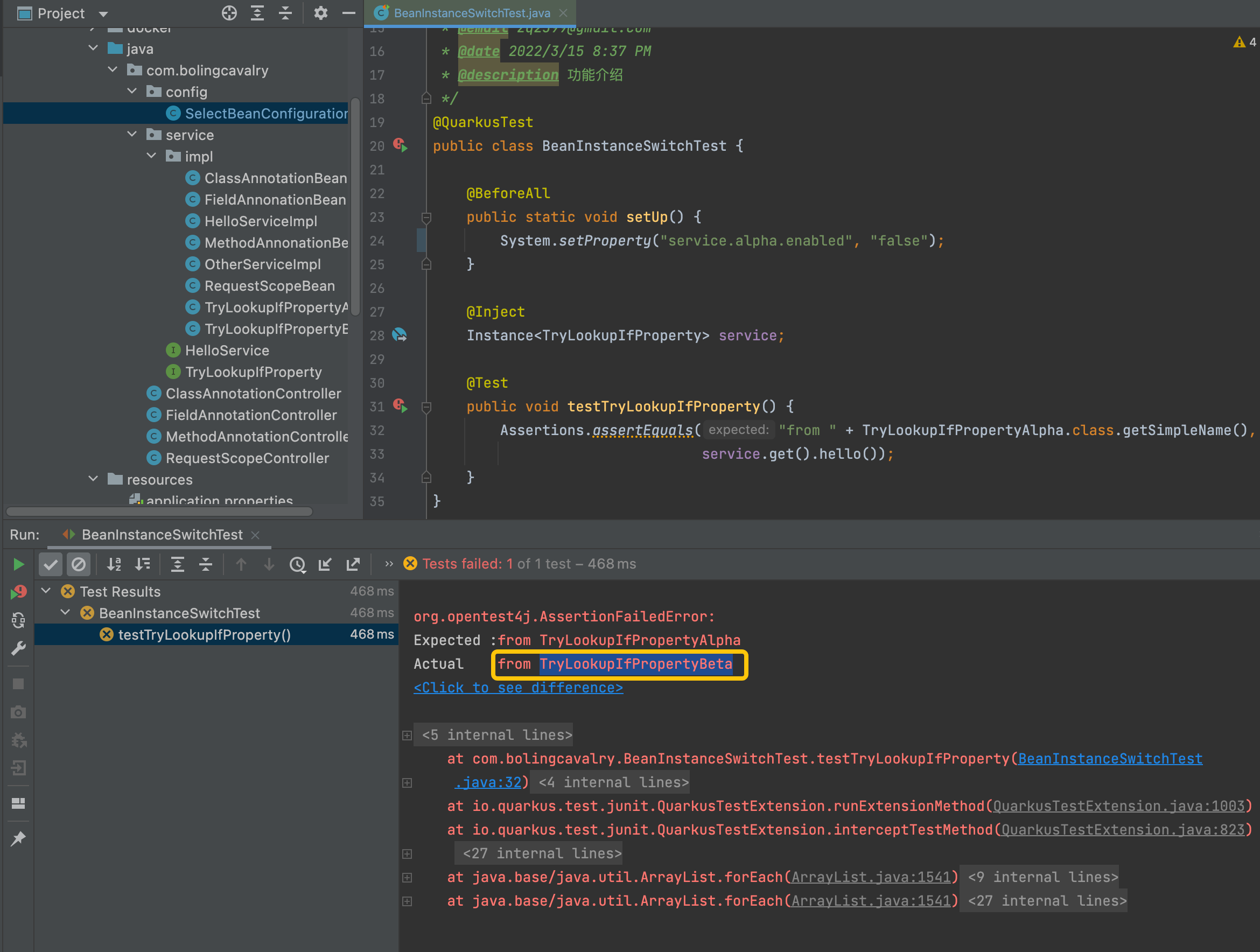
此刻您可能会好奇,如果配置项service.alpha.enabled不存在会如何,咱们将setUp方法中的System.setProperty这段代码删除,这样配置项service.alpha.enabled就不存在了,再次执行单元测试,发现SelectBeanConfiguration类的tryLookupIfPropertyAlpha和tryLookupIfPropertyBeta两个方法都没有执行,导致没有TryLookupIfProperty类型的bean
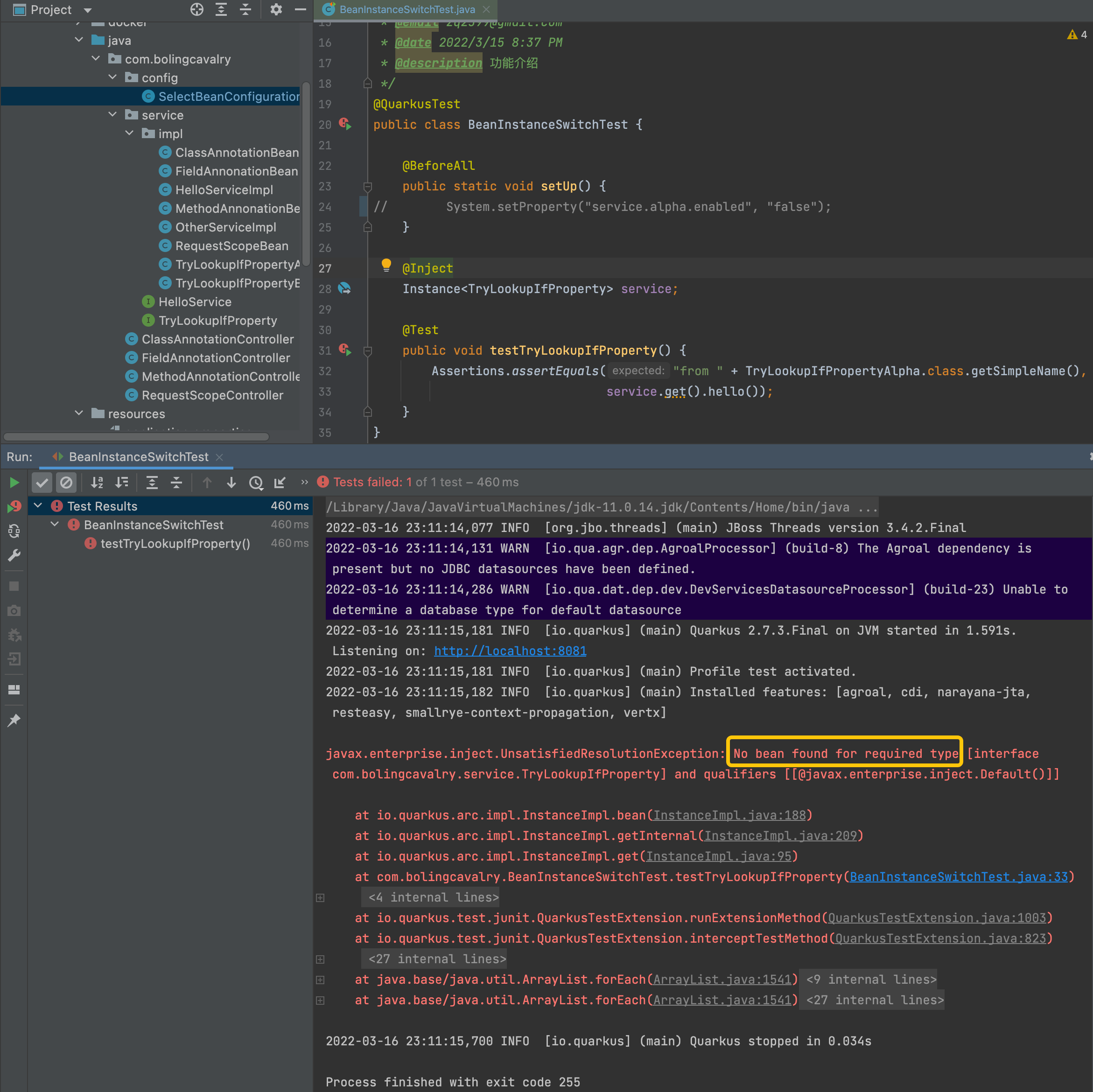
这时候您应该发现了一个问题:如果配置项service.alpha.enabled不存在的时候如何返回一个默认bean,以避免找不到bean呢?
LookupIfProperty和LookupUnlessProperty都有名为lookupIfMissing的属性,意思都一样:指定配置项不存在的时候,就执行注解所修饰的方法,修改SelectBeanConfiguration.java,如下图黄框所示,增加lookupIfMissing属性,指定值为true(没有指定的时候,默认值是false)

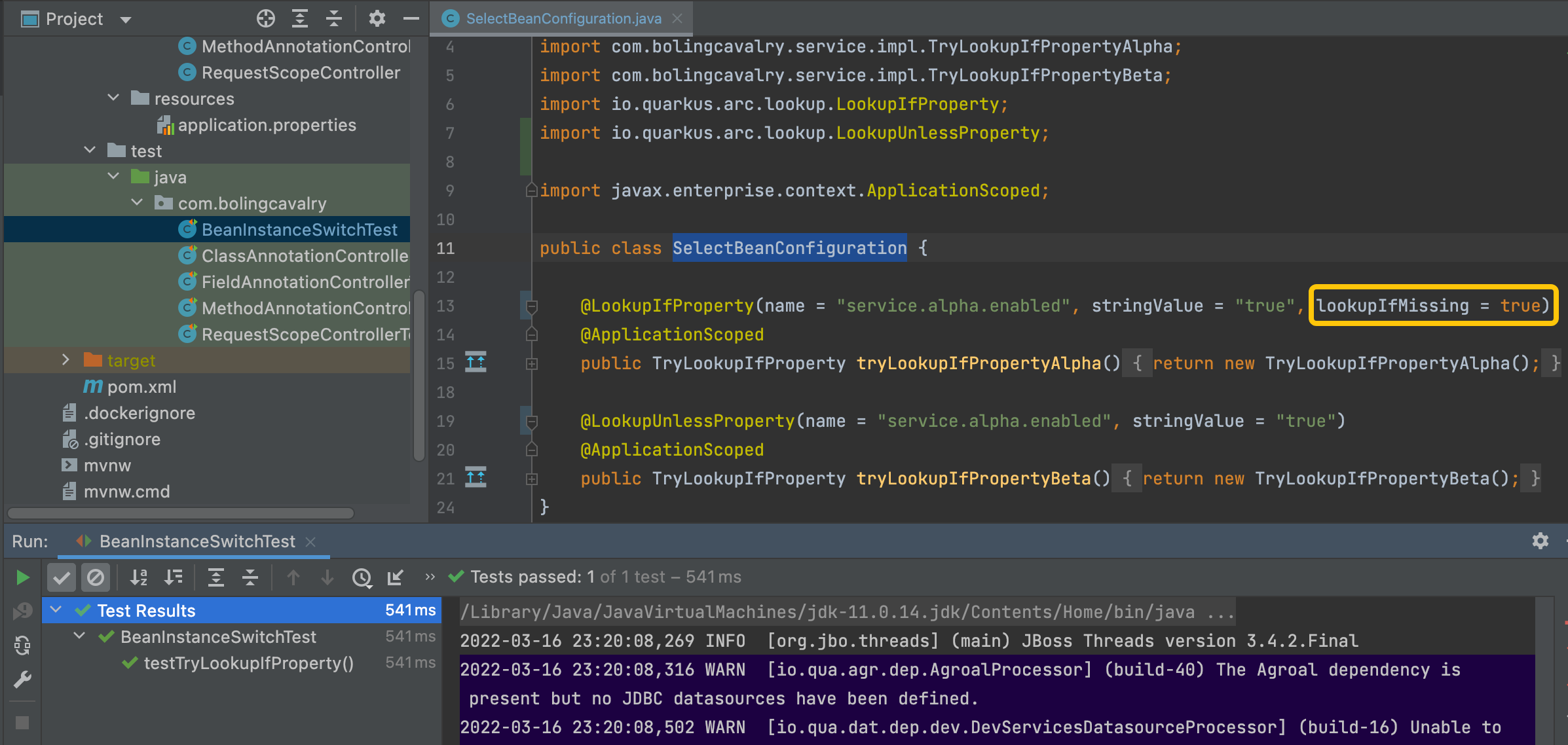
# LookupIfProperty,说的是be obtained by programmatic
Indicates that a bean should only be obtained by programmatic lookup if the property matches the provided value.
# IfBuildProfile,说的是be enabled
the bean will only be enabled if the Quarkus build time profile matches the specified annotation value.
复制public interface TryIfBuildProfile {
String hello();
}
复制public class TryIfBuildProfileProd implements TryIfBuildProfile {
@Override
public String hello() {
return "from " + this.getClass().getSimpleName();
}
}
复制public class TryIfBuildProfileDefault implements TryIfBuildProfile {
@Override
public String hello() {
return "from " + this.getClass().getSimpleName();
}
}
复制@Produces
@IfBuildProfile("test")
public TryIfBuildProfile tryIfBuildProfileProd() {
return new TryIfBuildProfileProd();
}
@Produces
@DefaultBean
public TryIfBuildProfile tryIfBuildProfileDefault() {
return new TryIfBuildProfileDefault();
}
复制单元测试代码写在刚才的BeanInstanceSwitchTest.java中,运行单元测试是profile被设置为test,所以tryIfBuildProfile的预期是TryIfBuildProfileProd实例,注意,这里和前面LookupIfProperty不一样的是:这里的TryIfBuildProfile直接注入就好,不需要Instance<T>来注入
@Inject
TryIfBuildProfile tryIfBuildProfile;
@Test
public void testTryLookupIfProperty() {
Assertions.assertEquals("from " + TryLookupIfPropertyAlpha.class.getSimpleName(),
service.get().hello());
}
@Test
public void tryIfBuildProfile() {
Assertions.assertEquals("from " + TryIfBuildProfileProd.class.getSimpleName(),
tryIfBuildProfile.hello());
}
复制执行单元测试,如下图,测试通过,红框显示当前profile确实是test

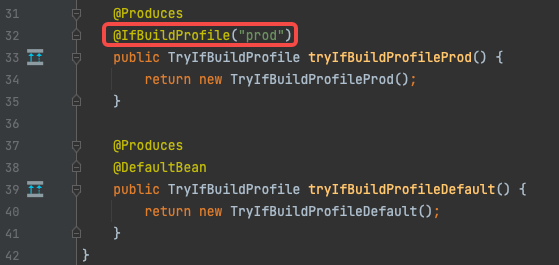
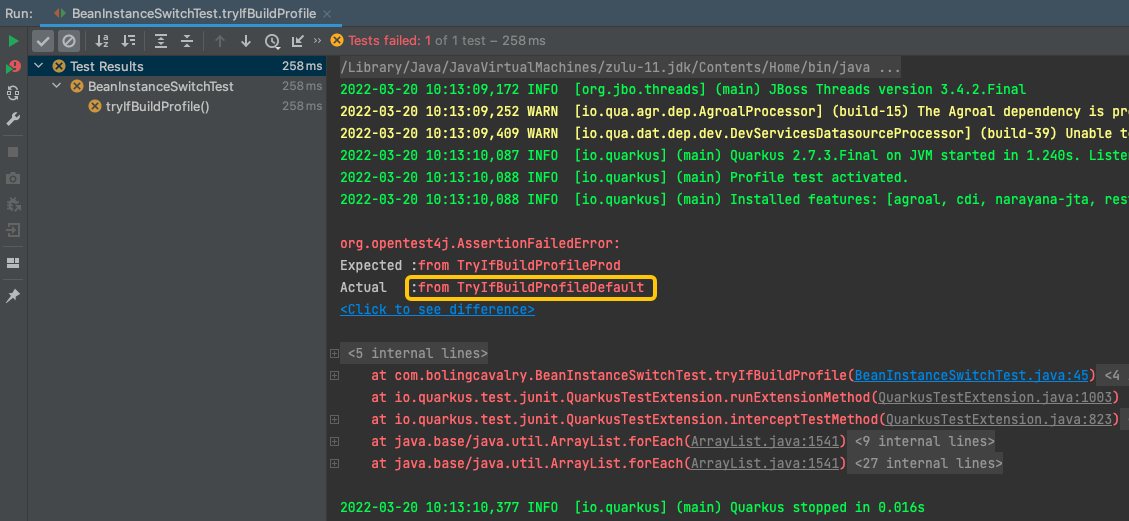
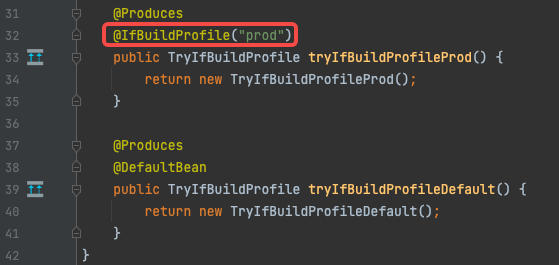
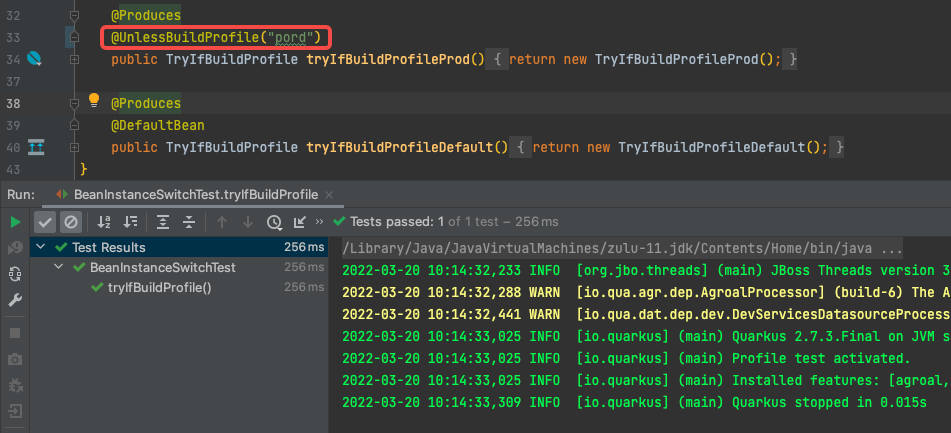
# LookupIfProperty的描述,如果属性匹配,则此bean可以被获取使用
Indicates that a bean should only be obtained by programmatic lookup if the property matches the provided value.
# IfBuildProperty的描述,如果构建属性匹配,则此bean是enabled
the bean will only be enabled if the Quarkus build time property matches the provided value
复制@Dependent
public class TracerConfiguration {
@Produces
@IfBuildProperty(name = "some.tracer.enabled", stringValue = "true")
public Tracer realTracer(Reporter reporter, Configuration configuration) {
return new RealTracer(reporter, configuration);
}
@Produces
@DefaultBean
public Tracer noopTracer() {
return new NoopTracer();
}
}
复制